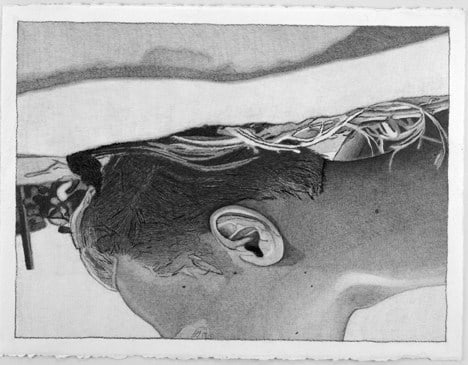
Early in the Sixteenth Century a new subject was introduced into Western European painting in Venice — the pastorale, now defined as "suggestive of idyllic rural life" but then quite often leaning toward an idyllic eroticized life. One of this new genre's earliest and surely most beautiful manifestations is Titian's Pastoral Concert (ca. 1510) in which two full-bodied standing nudes, one pouring water into a fountain, the other playing a flute, are joined with two seated and clothed male courtiers, one playing a lute - in a fertile rural landscape with a shepherd and sheep in the background. The architectural framework that had most often embraced Virgin and Child in Florentine painting now gave way, in Venice, to landscape. In one of Titian's renderings of this subject, the Virgin is seen in a verdant landscape, as she gently holds down a white rabbit with her left hand, while reaching out to the Christ Child with her right. A shepherd rests nearby with his sheep, and golden dusk gently subdues the sky. Two centuries later, the pastorale reached its apogee in the hands of Watteau (1684 - 1721) with his many paintings of figures in glistening garb, now in amorous pursuits now embarking on idyllic voyages - always enveloped in an evanescent froth of landscape - nowhere more fabulously than in The Embarkation for Cythera [1718 or 1719). Watteau's misty intimacies began to dissolve into coy rococo cosmetics under the brush of first Boucher (1703 - 1770) then Fraganard (1780 - 1850). Concurrently with the subject of the pastorale, from the early Sixteenth century onward, landscape frequently began to overwhelm the tiny figures of the narrative and pure landscape often spread across the entire painted plane.
The painting so often cited as the harbinger of modernism, Manet's dejeuner sur l'herbe (1862 - 63) seems to look back to Titian's Pastoral Concert, now with just one nude seated in the foreground together with two fully clothed men. However, unlike Titian's nudes, this nude looks directly out at the viewer with a kind of brazen nonchalance that shocked many a passerby. Perhaps as shocking was the nonchalance of Manet's brushstrokes and his brazen disdain of finish, especially apparent in the visible tracks of process left bare in the background. Manet had undressed painting. A decade later, so too would Cezanne's shifting blocks of strokes and Monet's ever more abstract liquification of the landscape. And on into the Twentieth century with Matisse's playfully amorous and lush Joie de Vivre (1905) harboring, in the background, the circle of dancers that would evolve so astoundingly into the first version of Dance in 1909, and Picasso's ferocious nudes extracted from El Greco, the angular expressiveness of many an African mask, and a local bordello in Barcelona, brutally crowded into Les Demoiselles D'Avignon (1907) to de Kooning's urban bitch goddesses rising out of storms of paint in his Paintings on the Theme of the Woman (1950-53) to be followed a decade later by the squishy nymphs frolicking in luminous eruptions of landscape allusions before dissolving completely into abstraction in the 1970s.
As modernism's options dwindled and artists began to re-explore previously banned alternatives, in the 1980's, the Pandora's box filled with illusion, metaphor, narrative, historic styles, a panoply of nudes and more was pried open. Post modernism the accumulation of these new freedoms was labeled, as so many of the referents that had influenced modernism's abstractions took on more mimetic form - flowerbeds might now arise out of Joan Mitchell's radiant abstract bursts of color titled Sunflowers; the rhythms of the ocean addressed with such lyric anxiety by Jackson Pollock might be more consciously regimented into recognizable sequences of waves, etc. Modernism would become but one of many possibilities for an artist. Landscape found fertile ground and pastorale could flourish. The ever-changing look of landscape-oriented art with or without participating figures becoming a pastorale gave rise to this exhibition. Not a grand survey but a small selection of works by seven artists who have impacted my mental landscape. Seven artists, each one's work occupying one of the seven available rooms of the exhibition space.
In the late 1980s, Peter Cain (1959 - 1997) painted cars variously truncated and most often stood on end and painted in searing fetish finish to become mysterious icons of mechanization. In the last year of his life, he turned to the landscape configuration best known to him - the gas station. His gas stations, with their emphasis on primary colors, severely geometricized composition almost totally limited to vertical and horizontal elements, and absence of all human and automobile presence might have been designed by a tern of Mondrian and DeChirico. Meticulously painted under cool clear light, Mobil (1996), like the other gas station works, is sparingly studded with misty shadows, puddles on the ground, and lovingly painted occasional blurred rectangles on the windows that give witness to more human and natural idiosyncrasies. When I asked what artists he most admired, "Robert Ryman and Richard Estes," he responded without a moment's hesitation. The gas station as landscape invader and surrogate becomes a shrine awaiting its altarpiece.
Before he painted the gas stations, Cain briefly moved away from the automotive to create huge paintings of the outsized portrait head of his beloved partner Sean against a sandy ocean beach - as though making a billboard out of his love. A number of drawings reprised these portraits on a more intimate scale. At once public and intimate these overscaled portraits are pastorales for our time.
To read the full essay, click PDF.